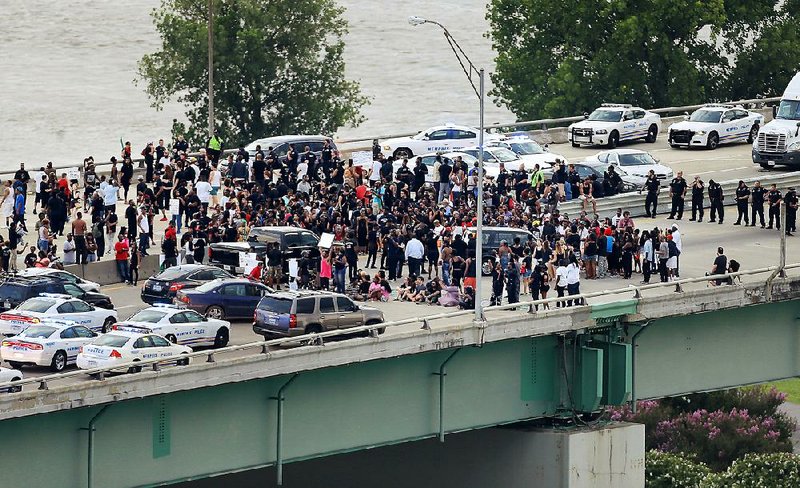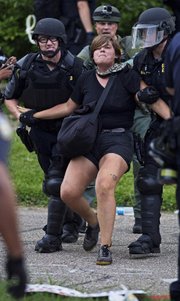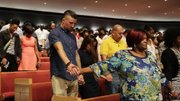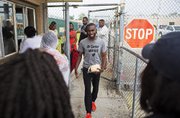MEMPHIS -- Hundreds of people blocked the Interstate 40 bridge over the Mississippi River on Sunday, a day when people across the country protested police shootings of black men in Louisiana and Minnesota.
Traffic on I-40 stopped in both directions after Black Lives Matter protesters marched onto the bridge. Police said they tried to stop them, but several hundred had already made their way up the ramp. The crowd was estimated at more than 1,000.
Memphis Police Department interim Director Michael Rallings locked arms in solidarity with people marching off the bridge, but several hundred people remained until riot police with shields pushed them back.
No arrests were reported in Memphis. About 160 people were taken into custody during protests in Baton Rouge, and about 100 were arrested in St. Paul, Minn.
In Baton Rouge, officers stared down hundreds of shouting protesters near a ramp onto Interstate 110 on Sunday night before another squad in riot gear arrived to make arrests.
Earlier Sunday, about 2,000 people rallied outside the Capitol building, state police Maj. Doug Cain said.
"They didn't have any problems out there. They seemed to be very organized and peaceful," Cain said.
But as night began to fall, a few hundred people aimed for an on-ramp.
After a lengthy standoff, police in full riot gear moved in, pinning some of the protesters as others fled. About 30 to 40 people were jailed for trying to block a highway, sheriff's office spokesman Casey Rayborn Hicks said.
Earlier, officers with rifles blocked ramps to keep protesters off Interstate 10 in the city's downtown.
"The police tactics in response have been very moderate. I'm very proud of that," said Louisiana Gov. John Bel Edwards, a Democrat who comes from a family of sheriffs.
The Baton Rouge police spokesman, Sgt. Don Coppola, blamed some violence and the number of arrests on outside agitators. One officer lost teeth because of a projectile thrown outside police headquarters, and police confiscated three rifles, three shotguns and two pistols during that protest, he wrote in an email.
"It appears the protest at Baton Rouge Police Headquarters has become more violent as out-of-town protesters are arriving," he said.
One of those protesters was DeRay Mckesson, a prominent Black Lives Matter activist who embraced supporters Sunday after spending the night in jail. He joined those protesting last week's fatal shooting of a 37-year-old black man, Alton Sterling, by two white police officers.
"I remain disappointed in the Baton Rouge police, who continue to provoke protesters for peacefully protesting," he said. "There's a lot of work to be done, with this Police Department specifically."
Mckesson was charged with obstructing a highway of commerce, said an East Baton Rouge Parish prison official, who spoke on the condition of anonymity because she was not authorized to talk to reporters.
Minnesota protests
In Minnesota, authorities said 21 St. Paul officers and six state troopers were hurt late Saturday and early Sunday.
Police used smoke bombs to clear more than 200 people blocking Interstate 94, the main highway in and out of the Twin Cities of Minneapolis and St. Paul. Protesters pelted police in riot gear with rocks, bottles, firecrackers and other objects, and they refused to get off the highway, prompting officers in riot gear to move in just after midnight Saturday.
Roughly half of the arrests happened during that standoff. Most of the others happened early Sunday in another part of St. Paul.
Police Chief Todd Axtell called the violence against officers "a disgrace."
The protest in St. Paul started Saturday night with a march from the governor's mansion, where protesters have been gathering since the fatal police shooting Wednesday of a black driver, Philando Castile, in the suburb of Falcon Heights. The 32-year-old school cafeteria supervisor told officers during a traffic stop that he had a gun in the car and a permit to use it, and one of them shot him when he reached for his wallet, according to his girlfriend, who live-streamed video of the immediate aftermath on Facebook.
Tyree Johnson, a protester who said he was Castile's cousin, said officers on the highway fired pellets and gas in his direction.
Misty Macon, 20, of St. Paul, said the protest was mostly peaceful, though at least one protester aimed fireworks at an officer. She said she saw about 30 people being peacefully taken away by officers, who said they warned protesters they would be subject to arrest if they didn't leave the interstate, which reopened early Sunday.
Mike Martin, who wore a guitar on his back and said he was trying to promote peace, was pepper-sprayed by an officer on a pedestrian bridge overlooking the interstate. He said he was trying to move the crowd along and keep the peace.
"I guess I wasn't moving fast enough for him," said Martin, who said the officer was 6 feet away when he sprayed him without warning. "He just got it out and bam, I saw a cloud. It's burning pretty bad."
In the South, Memphis police kept watch on about 100 people honoring Nathan Bedford Forrest, a Confederate general and early Ku Klux Klan leader, in the city park where he is buried.
And in Columbia, S.C., several hundred people blocked a downtown intersection in protest of the reappearance of the Confederate battle flag outside the South Carolina Statehouse. Earlier Sunday, the South Carolina Secessionist Party temporarily raised the flag at the same site where it was taken down after a vote by the South Carolina Legislature a year ago.
Dallas investigation
Meanwhile, Dallas police are investigating the meaning of "R.B.," the letters that Micah Xavier Johnson wrote in blood on the walls of t̶h̶e̶ ̶d̶o̶w̶n̶t̶o̶w̶n̶ ̶D̶a̶l̶l̶a̶s̶ ̶p̶a̶r̶k̶i̶n̶g̶ ̶g̶a̶r̶a̶g̶e̶ where he died last week after he opened fire on police and protesters, killing five officers.
Police Chief David Brown said Sunday that the "R.B." initials indicate that Johnson was wounded when he barricaded himself in the downtown building, where Brown later ordered officers to use a remote-controlled robot armed with explosives to kill him.
Brown told CNN that police also found a journal in which Johnson, an Army veteran, detailed tactical movements, including one called shoot and move. The tactic is meant to create confusion about the number and location of gunmen, keep a shooter safe from return fire, and maximize the amount of damage inflicted on targets, said Dallas County Judge Clay Jenkins.
Johnson is believed to have shot from several different positions Thursday night. A video taken during the shootings shows a man believed to be Johnson shooting at a police officer from behind a pillar, moving closer to shoot from near point-blank range, and then moving away in the opposite direction.
"It looked like we had more than one shooter and they were triangulating on our officers from different positions," Jenkins said.
Communications during the initial chaos of the shooting, as officers huddled behind cruisers and protesters scrambled for cover, indicated there were multiple shooters. Jenkins said the journal was a key piece of evidence leading police to believe that Johnson was the only shooter.
"When you look at the shoot-and-move tactics, the abilities he had because of the structure of the building, the journal buttresses the theory that the man acted alone," Jenkins said.
Since the shootings, police have kept several downtown blocks taped off as a crime scene while they determine the locations of victims, where officers were when they returned fire and a timeline of Johnson's movements.
When Johnson was barricaded in the parking garage, he told police he acted alone, Jenkins said.
Officials on Sunday said they were still investigating whether anyone knew about the man's plans. Brown said police were still going through Johnson's laptop and cellphone to determine whether others are connected, and they "haven't ruled out whether or not others are complicit."
Brown also expanded on Johnson's motivations and behavior during the standoff Thursday night. He said the investigation suggests that Johnson had long prepared for the attack but fast-tracked his plan after the announcement of the protest march against the shootings in Louisiana and Minnesota.
The chief said police are "convinced this suspect had other plans and thought that what he was doing was righteous" and was determined to "make us pay for what he sees as law enforcement's efforts to punish people of color."
Asked what he'd say to demonstrators across the country who have taken to the streets in protest of police shootings of black men, Brown said: "We are sworn to protect you and your right to protest, and we will give our lives for it."
He compared the tension between law enforcement officials and demonstrators to a relationship in which "you love that person, but that person can't express or show that love back."
Information for this article was contributed by Katie Leslie of The Dallas Morning News; by Michael Kunzelman, Rebecca Santana, Janet McConnaughey, Sadie Gurman and Skip Foreman of The Associated Press; and by Wesley Lowery of The Washington Post.
A Section on 07/11/2016
*CORRECTION: Micah Johnson, 25, the man suspected of killing five police officers and wounding seven others in a shooting Thursday, was killed by police using a remote-controlled robot on the second floor of El Centro College in downtown Dallas, Police Chief David Brown said Monday. Brown acknowledged that the department incorrectly described for several days where Johnson was cornered by police. Because of the faulty information, this story incorrectly described where Johnson was killed.



